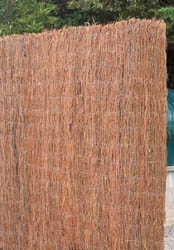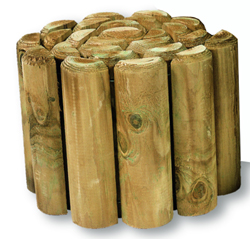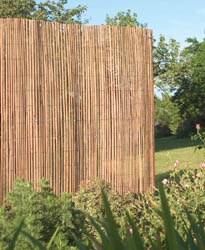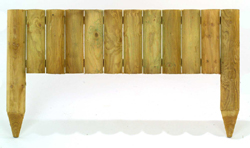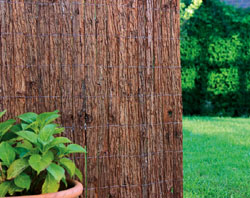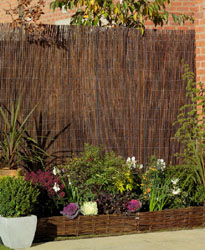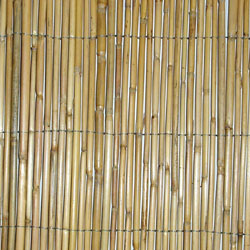
01757 28939701757 289397

UK Farm Supplies Ellerton, York, United Kingdom,
Garden News
Mahonias Shrubs
Mahonias are a very useful shrub - they are evergreen, have characteristic holly-like leaves and carry a profusion of yellow flowers in winter followed by purple berries. Some of the species grow well in shade and all are good for cutting in winter when not too much else is available.
They can be planted in any decent garden soil, the larger leaved species being especially suited to damp soils and shady conditions. They may be a bit slow to take off, but once established are generally undemanding. No especial pruning is needed, just keep the plant the size and shape that you want.
Propagation is by seed, or cuttings from the current season’s growth 2-2.5 cms long in late July, put into pots of peat/sand and ideally provide some bottom heat from a propagator.
There are a number of varieties:
Aquifolium height about 1m spread 1.5 m. Fragrant yellow flowers, with many flowers forming globs in March or April. Good groundcover and tolerates wind. Leaves normally green, but atropurpurea turn a bronzy purple in winter.
Japonica height 2.5m, spread 2.5m. Long fragrant racemes of yellow flowers, racemes tend to droop rather than stand up like those of Flowers February.
Media There are two important cultivars of this hybrid of japonica:
Charity height 2.5m, spread 2m. The common variety in garden centres. Long fragrant racemes of yellow flowers in November to February,
Buckland very similar but with arching racemes.
They can be planted in any decent garden soil, the larger leaved species being especially suited to damp soils and shady conditions. They may be a bit slow to take off, but once established are generally undemanding. No especial pruning is needed, just keep the plant the size and shape that you want.
Propagation is by seed, or cuttings from the current season’s growth 2-2.5 cms long in late July, put into pots of peat/sand and ideally provide some bottom heat from a propagator.
There are a number of varieties:
Aquifolium height about 1m spread 1.5 m. Fragrant yellow flowers, with many flowers forming globs in March or April. Good groundcover and tolerates wind. Leaves normally green, but atropurpurea turn a bronzy purple in winter.
Japonica height 2.5m, spread 2.5m. Long fragrant racemes of yellow flowers, racemes tend to droop rather than stand up like those of Flowers February.
Media There are two important cultivars of this hybrid of japonica:
Charity height 2.5m, spread 2m. The common variety in garden centres. Long fragrant racemes of yellow flowers in November to February,
Buckland very similar but with arching racemes.
Bedding Plants
Many garden centres and supermarkets are selling off their bedding plants now, and we occasionally add to our collections at this time. We have to be careful with our selection, as often the trays of plants have been sadly neglected, as the watering spray frequently does not reach the inner stages of the shelves. However, if we do select carefully, a bargain can be obtained. As our weather patterns seem to be changing almost noticeably, we can assume that there is still a fair bit of good weather ahead. So many of the tasks which were traditionally performed in September have now moved to October. However, to leave all till later in the year is a gamble which may backfire. One chore which should be achieved sooner rather than later is the protecting of wooden garden furniture. When it is fully dry, a coat or even two of a preservative paint should be applied, concentrating especially on horizontal surfaces and joints, making sure that the paint is worked well in. Thus, not only will your furniture look tidier, it will be well protected against winter weather.
I think I have mentioned the rope sculpture moon gate which sits framing the Viburnum Plicatum. Being under trees, it gradually turned green instead of white. So it was tackled by means of a pressure washer, which forced the algae off the rope, and returned the moon gate to its pristine white condition. Some items of garden statuary look their best when bright and clean, but we have a number of statues which we think look better with mosses and lichens making them look ancient. In furniture terms it adds a patina.
A number of windy days have resulted in quite a lot of timber falling out of our oak trees, and some from the conifers. Many of the oak branches are quite rotten, so they will be added to the pile which we have created as a wildlife shelter and food source. The rest will be added to the bonfire.
I think I have mentioned the rope sculpture moon gate which sits framing the Viburnum Plicatum. Being under trees, it gradually turned green instead of white. So it was tackled by means of a pressure washer, which forced the algae off the rope, and returned the moon gate to its pristine white condition. Some items of garden statuary look their best when bright and clean, but we have a number of statues which we think look better with mosses and lichens making them look ancient. In furniture terms it adds a patina.
A number of windy days have resulted in quite a lot of timber falling out of our oak trees, and some from the conifers. Many of the oak branches are quite rotten, so they will be added to the pile which we have created as a wildlife shelter and food source. The rest will be added to the bonfire.
Making Gardens Plant friendly
We saw last time how to deal with seriously waterlogged soil, but if yours is not that bad, no standing water or bog grass then lesser measures are appropriate. If you live in very low lying land and the water table is high there is little you can do other than use raised beds, but if it is just that you have a heavy, slow draining soil, then digging and incorporating some fine grit and as much compost/well rotted manure as possible will usually solve the problem. If you soil is acid (pH less than 7) then use this opportunity to add lime (do ensure that it is garden lime you use, not builders lime, they are very different!). Lime is sometimes key to lightening a heavy soil.
If you have a dry sandy soil, then your solution is easy, simply dig in a large amount of organic matter, the more you add the better the result think in terms of a ton or two of manure, local council compost or spent mushroom compost for a very small garden. Thereafter topping up at a kg or two per square metre annually will keep the soil healthy.
Acid soil can be corrected by addition of lime, but unfortunately there is no good way to acidify and alkaline soil. So if you live on chalk or limestone the only way to grow rhododendrons is in a raised and ideally sealed bed.
You will have noticed that for many problems we have recommended digging in of manure/compost. This is because there is much to be gained from a high humus content not only is the soil structure improved, but also a healthy environment for good fungi and bacteria is creared, these will encourage the insects you want and between them all these microbeasts will keep your plants in good shape as well as your soil.
Finally, the advantage of choosing to grow the right plants cannot be overstated, see what works locally and follow that lead then expand with plants of similar requirements.
Wet/dry
Acid/alkaline
Humus
Choose right plants
If you have a dry sandy soil, then your solution is easy, simply dig in a large amount of organic matter, the more you add the better the result think in terms of a ton or two of manure, local council compost or spent mushroom compost for a very small garden. Thereafter topping up at a kg or two per square metre annually will keep the soil healthy.
Acid soil can be corrected by addition of lime, but unfortunately there is no good way to acidify and alkaline soil. So if you live on chalk or limestone the only way to grow rhododendrons is in a raised and ideally sealed bed.
You will have noticed that for many problems we have recommended digging in of manure/compost. This is because there is much to be gained from a high humus content not only is the soil structure improved, but also a healthy environment for good fungi and bacteria is creared, these will encourage the insects you want and between them all these microbeasts will keep your plants in good shape as well as your soil.
Finally, the advantage of choosing to grow the right plants cannot be overstated, see what works locally and follow that lead then expand with plants of similar requirements.
Wet/dry
Acid/alkaline
Humus
Choose right plants
Designer Shrub
Have you noticed the increase in designer plants? You can get fruit trees with more than one variety of apple, stepover cordon fruit bushes, shrubs with multicoloured flowers to say nothing of the explosion in colours and form of just about every known flowering plant you have ever heard of.
Well how do you fancy designing your own shrub? It is so simple!
Think of half a dozen things you would like this shrub to be. Say, for instance,
fragrant flowers in winter
flowering in summer
coloured foliage
edible fruit
some variegation
Now for the fun, choose one shrub that will give you each of these properties, so you may choose Viburnum Bodnantense for the fragrant flowers in winter, a Philadelphus for summer flowers, possibly cotinus coggygria for purple leaves (and more), a dwarf apple (bush apple) for fruit and maybe a cornus mas for variegation (it will also give you flowers in early spring).
Now what you should do is to write down each shrub chosen along with its eventual height and growth rate. Now see if you can replace any which have the greatest or least height or rate of growth with another variety that will be more in line with the others.
Now you are ready to get your plants and prepare your ground. Plant the shrubs in a circle so that there is about 500mm between plants (less if they are small and slow growing, more if they are tall and fast growing). Now as they grow they will become a one-shrub, and you will have just exactly what you wanted.
Do give some thought to which shrub you want where in the circle I would suggest winter flowers should be seen from the house or a frequently used path. Also by using 5 plants, have you got a large enough super shrub? (5 shrubs planted in a circle 500mm apart, will make a super-shrub of about 85 cm diameter; 10 shrubs 50 cms apart would give a super-shrub about 170 cm diameter). If you want to increase the size of your super shrub you can use more than one shrub of each variety you have already chosen or bring in some different ones of similar growth habit.
All that remains now is some judicious pruning to keep your super shrub looking like a single plant (and any fruit bushes fruiting). One word of warning don’t let it get too tall, you have to be able to reach the middle at the top!
Well how do you fancy designing your own shrub? It is so simple!
Think of half a dozen things you would like this shrub to be. Say, for instance,
fragrant flowers in winter
flowering in summer
coloured foliage
edible fruit
some variegation
Now for the fun, choose one shrub that will give you each of these properties, so you may choose Viburnum Bodnantense for the fragrant flowers in winter, a Philadelphus for summer flowers, possibly cotinus coggygria for purple leaves (and more), a dwarf apple (bush apple) for fruit and maybe a cornus mas for variegation (it will also give you flowers in early spring).
Now what you should do is to write down each shrub chosen along with its eventual height and growth rate. Now see if you can replace any which have the greatest or least height or rate of growth with another variety that will be more in line with the others.
Now you are ready to get your plants and prepare your ground. Plant the shrubs in a circle so that there is about 500mm between plants (less if they are small and slow growing, more if they are tall and fast growing). Now as they grow they will become a one-shrub, and you will have just exactly what you wanted.
Do give some thought to which shrub you want where in the circle I would suggest winter flowers should be seen from the house or a frequently used path. Also by using 5 plants, have you got a large enough super shrub? (5 shrubs planted in a circle 500mm apart, will make a super-shrub of about 85 cm diameter; 10 shrubs 50 cms apart would give a super-shrub about 170 cm diameter). If you want to increase the size of your super shrub you can use more than one shrub of each variety you have already chosen or bring in some different ones of similar growth habit.
All that remains now is some judicious pruning to keep your super shrub looking like a single plant (and any fruit bushes fruiting). One word of warning don’t let it get too tall, you have to be able to reach the middle at the top!
Sound in the Garden
Sound in the garden can be very pleasant and relaxing, but it is probably only if your garden is normally quiet that you can use the low volume sounds that we usually think of as relaxing. If you live close to a motorway or busy main road you may need to look for louder, less natural sounds to mask the traffic noise.
Perhaps the most relaxing sound of all is water. It needs to be a fountain or a bubbler or ideally a small waterfall. The amount of noise your water will make will be pretty much proportional to the volume of water creating the sound, and hence to the power and expense of your pump. You can do a couple of things to maximise the sound; for instance a fountain or bubbler needs to drop back into water at least 20% as deep as the height of the water height in the air; a waterfall will be noisier if it flows fast but turbulently through stones or rocks. These delicate sounds are soon lost so make sure that your water feature is close to where you will be when you want to hear it.
While you are working with the pond ensure that it has at least one end which is sloped so that frogs and toads, to say nothing of the gentle plops as they jump back into the water.
Have a bird table and put out food on a regular basis; this will keep songbirds close to you, pleasant sounds all summer and colourful birds to watch in the winter.
Your final option for some natural noise is windchimes. The range of sounds available from woodwind through metallic chimes to percussion is amazing, but there is also variation in the amount of wind required to get them performing, so if you live in a very sheltered setting you will need to choose wisely. Wind will also make noise as it blows though certain types of plant-bamboos particularly
Perhaps the most relaxing sound of all is water. It needs to be a fountain or a bubbler or ideally a small waterfall. The amount of noise your water will make will be pretty much proportional to the volume of water creating the sound, and hence to the power and expense of your pump. You can do a couple of things to maximise the sound; for instance a fountain or bubbler needs to drop back into water at least 20% as deep as the height of the water height in the air; a waterfall will be noisier if it flows fast but turbulently through stones or rocks. These delicate sounds are soon lost so make sure that your water feature is close to where you will be when you want to hear it.
While you are working with the pond ensure that it has at least one end which is sloped so that frogs and toads, to say nothing of the gentle plops as they jump back into the water.
Have a bird table and put out food on a regular basis; this will keep songbirds close to you, pleasant sounds all summer and colourful birds to watch in the winter.
Your final option for some natural noise is windchimes. The range of sounds available from woodwind through metallic chimes to percussion is amazing, but there is also variation in the amount of wind required to get them performing, so if you live in a very sheltered setting you will need to choose wisely. Wind will also make noise as it blows though certain types of plant-bamboos particularly
Art of Surprise in Garden Design
There are a number of things that can make your garden memorable to those who visit, but one of the most important of these is surprise, after going through a dark tunnel, you round the final bend and emerge into a Chinese pavilion overlooking a lake which at the time was bathed in bright sunlight. It was stunning.
So how can you achieve something similar? Here are a few suggestions.
Your surprise will be easier to generate if you have the equivalent of the Biddulph tunnel that is a path where you cannot see what is beyond, so you need to go round a corner or emerge from some dense tree or shrub planting. What you see when you get to the point needs to be very different from what you have seen thus far, and the more vivid and the closer it is, the bigger the surprise. Imagine the effect of a metre high lifelike sculpture of a spider, very close certainly a surprise, but possibly not to everyone’s taste!
An attractive pond well planted up could work well, or if you have just come from a flower-less wood or shrubbery, a good sized very bright flower bed would be a good contrast. Sculpture of any sort, especially brightly coloured would be good, an unseen distant view, especially when cleverly framed is also effective.
If you cannot generate this “rounding a corner” effect, then maybe you could make use of the PIR sensors we discussed last week, and use (safely installed and RCD protected) outside wiring to start a mister or make a sound, or if it is an enclosed, dark area, turn on a light.
The possibilities are endless.
So how can you achieve something similar? Here are a few suggestions.
Your surprise will be easier to generate if you have the equivalent of the Biddulph tunnel that is a path where you cannot see what is beyond, so you need to go round a corner or emerge from some dense tree or shrub planting. What you see when you get to the point needs to be very different from what you have seen thus far, and the more vivid and the closer it is, the bigger the surprise. Imagine the effect of a metre high lifelike sculpture of a spider, very close certainly a surprise, but possibly not to everyone’s taste!
An attractive pond well planted up could work well, or if you have just come from a flower-less wood or shrubbery, a good sized very bright flower bed would be a good contrast. Sculpture of any sort, especially brightly coloured would be good, an unseen distant view, especially when cleverly framed is also effective.
If you cannot generate this “rounding a corner” effect, then maybe you could make use of the PIR sensors we discussed last week, and use (safely installed and RCD protected) outside wiring to start a mister or make a sound, or if it is an enclosed, dark area, turn on a light.
The possibilities are endless.
Cut Flowers
If you are going to grow flowers in your garden it makes good sense to grow at least some which can be cut and brought indoors, or even given as gifts to friends and relations. It also means that at least some of your plants get dead-headed really early, thus in most cases extending the flowering season.
So what makes a good cut flower? It should be long lasting, of interesting form and possibly scent and I guess for purists, fit in with room décor and scale. Lilies, although often sold as cut flowers, are not really fit for the purpose, they have stamens whose pollen will indelibly stain anything it touches and in all but the largest of areas the scent can become oppressive. While on the subject of the useful life of a cut flower do cut the bottom half inch or so off stalks before putting in water, and then refresh the water, trimming the stalks again every couple of days.
The earliest cut flowers of the year are mostly bulbs- snowdrops, daffodils, narcissus and tulips; but definitely consider forsythia to give a bit of structural architecture to your arrangement. In a similar vein, viburnum is useful and if you are using bodnantense it will be perfumed as well, as are lilac and a lot of roses. Other scented flowers for cutting include dianthus, sweet peas (they don't last very long), lavender, philadelphus and nicotiana.
Lily of the valley is another perfumed flower good for cutting and it doesn't have the pollen problems of other lilies.
For colour clarkia is hard to beat although it is a bit untidy. Some antirrhinum, verbenas and of course dahlias are very good for colour, as are cosmos, achillea, helichrysum, freesia, monarda, rudbeckia and zinnia.
For winter arrangements, you may have to rely on dried flowers, typically achillea, solidago, verbena, or astilbe. However there are many interesting shapes such as the dried heads of echinops or eryngium or even cardoon that is often grown for its architectural foliage (and whose blanched stems are delicious)
Garden Work
Jobs for April
With this year being 3-4 weeks behind last year, there are still probably some of the jobs normally done in March to finish off. Hopefully decent weather is here to stay now, so a big effort in the next couple of weeks can get us back on the tracks.
When you are in a position to move on, think primarily of feeding your plants. Trees, and shrubs can be given mulches of compost or well-rotted manure (fresh manure is too acidic and can kill any tender plants), Flower beds can receive a sprinkling of growmore plus a sprinkling of high potassium fertiliser such as tomato food to encourage flowering.
Climbers will probably start moving sometime this month, so keep them tied in to their support to prevent any damage from strong winds of heavy rain.
This is the last month to lift and divide any perennials. When replanting if the centre is hard and woody leave it out, the edge material will be more vigorous and flower better.
Prune any shrubs that have flowered, such as forsythia, so that they will put on vigorous new growth to flower next spring. The same goes for winter flowering heathers trimming them now will prevent them getting leggy.
Dead head daffodils, tulips etc but leave the leaves to die back naturally after they have put strength back into the bulbs.
Look to the lawn and re-sow or turf and bare patches, aerate and areas which have become compacted by being walked on in the wet weather. Moss can be removed when you have the time.
Finally, it is time to start weeding before the task begins to look impossible! Also keep a check on containers which will start to need more water
With this year being 3-4 weeks behind last year, there are still probably some of the jobs normally done in March to finish off. Hopefully decent weather is here to stay now, so a big effort in the next couple of weeks can get us back on the tracks.
When you are in a position to move on, think primarily of feeding your plants. Trees, and shrubs can be given mulches of compost or well-rotted manure (fresh manure is too acidic and can kill any tender plants), Flower beds can receive a sprinkling of growmore plus a sprinkling of high potassium fertiliser such as tomato food to encourage flowering.
Climbers will probably start moving sometime this month, so keep them tied in to their support to prevent any damage from strong winds of heavy rain.
This is the last month to lift and divide any perennials. When replanting if the centre is hard and woody leave it out, the edge material will be more vigorous and flower better.
Prune any shrubs that have flowered, such as forsythia, so that they will put on vigorous new growth to flower next spring. The same goes for winter flowering heathers trimming them now will prevent them getting leggy.
Dead head daffodils, tulips etc but leave the leaves to die back naturally after they have put strength back into the bulbs.
Look to the lawn and re-sow or turf and bare patches, aerate and areas which have become compacted by being walked on in the wet weather. Moss can be removed when you have the time.
Finally, it is time to start weeding before the task begins to look impossible! Also keep a check on containers which will start to need more water
Some Gardens to Visit
Gardens to Visit - Trebah
Trebah is about 5 miles southwest of Falmouth on the north shore of the Helford River estuary.
Although the garden was started with some excellent tree planting by Charles Fox in the 1830’s and 40’s and addition of many rare plants by the Backhouses and the Hexts, they were neglected between the start of the second World War and 1980. In the 1944 the beach on the Helford river was concreted over and 7500 US troops set sail from here to Omaha Beach as part of the D-Day operation.
In 1980 Tony and Eira Hibbert bought the house and were persuaded to restore the gardens to their former glory. This was a massive undertaking and has resulted in a truly world class garden which you should not fail to visit if you are in the area.
The stand-out feature of this garden is the way that it has been made to flow form one area to the next without the use of garden rooms and their artificial divisions. The wonderful basic structure provided by Fox’s inspired tree planting provides not only brilliant skyscapes but also a perfect stage for the natural lower plantings.
Anyone thinking of planting hydrangeas should certainly pay a visit in Autumn to see just how spectacular these shrubs can be the banks of the stream down by the Mallard Pond are a picture of blue and white with red highlights. At this time of year the acer glade is also at its best.
In Spring rhododendrons, azaleas, and magnolias provide the highlights, and features such as the private beach, the koi pond, water garden, amphitheatre etc provide year round interest.
An amusing tale is that in 1934 the Prince of Wales was being shown round, and was so impressed with the bunches of bananas on the banana palms that he gave the head gardener a substantial amount of money. The head gardener was sacked the next day, not for tying the bananas onto the trees, but for leaving a label on!
Visit to Rousham
If you only ever visit one garden it should be Rousham in Oxfordshire. It’s 25 acres are mostly parkland developed and planted by William Kent in 1738 for the Dormer family whose continuing line still live in the house.
What makes it so truly stunning is the combination of architecture, statuary and planting. Everywhere you walk there is something attracting your attention and making you want to carry on and investigate further and there being an estimated 1000 routes you can take around the garden you will appreciate just what an achievement this is.
But the interest is even deeper than this, Kent developed the grounds with a minimum of earth movement and achieved his result by clever use of the natural contours of the land and clever planting. By doing this he has created a large number of long views, be they to statues , buildings or borrowed views of the surrounding countryside.
Kent’s theme for the garden was Arcadia (an area of Greece which is seen as a rural, pastoral idyll) and to fit in with this the architecture is classic Greek in style, and the statuary is all of Greek mythological characters. At the time the garden was developed the upper classes were very well versed in Greek mythology and the symbolism and relevance of the statues and their placement within the garden would not have been lost on them. As Monty Don points out in his excellent book Around the World in 80 Gardens this is perhaps the equivalent of a garden being designed around the theme of a popular soap opera today!
There is in addition to this parkland a walled garden which used to be the kitchen garden, this is the place to see flowers (there is a magnificent herbaceous border), a knot garden and vegetables. In the centre is a most attractive pigeonnier. The rest of the space inside the walls is grassed and makes a wonderful usable space for the family when visitors are not around.
Do not miss this gem of garden design.
Visit to Great Comp
Great Comp is at relatively small garden at 7 acres and is situated at Borough Green near Sevenoaks in Kent. This is one of my favourite gardens for a number of reasons which will become clear later.
The garden was created by Roderick and Joy Cameron who moved there in 1957. It was opened to the public some 11 years later, and is now run by a curator with two full time and one part time gardeners along with a band of volunteers. There is an annual festival of chamber music in the stables.
The main features of the garden are long shrub beds with unusually effective under-planting, the Italianate Garden and some very pleasant woodland walks. It is perhaps best known for its collection of salvias (reputed to be one of the best in Europe), its rhododendrons and azaleas underplanted with hellebores.
During the creation of the garden the Camerons had to remove a great number of large stones, but instead of just piling them up in a quiet corner or paying to get them removed they used them to build a mock ruin and extremely effective it is too!
Another of my favourite features is the moon gate on the path that leads to the Oast house. These circular gates originated in China, and there are some in other countries, but I don’t think I have ever seen one used to better effect than here.
A small garden but definitely not one to be missed, the scale and the ideas are such that you can pick up many features to include in your own garden
Trebah is about 5 miles southwest of Falmouth on the north shore of the Helford River estuary.
Although the garden was started with some excellent tree planting by Charles Fox in the 1830’s and 40’s and addition of many rare plants by the Backhouses and the Hexts, they were neglected between the start of the second World War and 1980. In the 1944 the beach on the Helford river was concreted over and 7500 US troops set sail from here to Omaha Beach as part of the D-Day operation.
In 1980 Tony and Eira Hibbert bought the house and were persuaded to restore the gardens to their former glory. This was a massive undertaking and has resulted in a truly world class garden which you should not fail to visit if you are in the area.
The stand-out feature of this garden is the way that it has been made to flow form one area to the next without the use of garden rooms and their artificial divisions. The wonderful basic structure provided by Fox’s inspired tree planting provides not only brilliant skyscapes but also a perfect stage for the natural lower plantings.
Anyone thinking of planting hydrangeas should certainly pay a visit in Autumn to see just how spectacular these shrubs can be the banks of the stream down by the Mallard Pond are a picture of blue and white with red highlights. At this time of year the acer glade is also at its best.
In Spring rhododendrons, azaleas, and magnolias provide the highlights, and features such as the private beach, the koi pond, water garden, amphitheatre etc provide year round interest.
An amusing tale is that in 1934 the Prince of Wales was being shown round, and was so impressed with the bunches of bananas on the banana palms that he gave the head gardener a substantial amount of money. The head gardener was sacked the next day, not for tying the bananas onto the trees, but for leaving a label on!
Visit to Rousham
If you only ever visit one garden it should be Rousham in Oxfordshire. It’s 25 acres are mostly parkland developed and planted by William Kent in 1738 for the Dormer family whose continuing line still live in the house.
What makes it so truly stunning is the combination of architecture, statuary and planting. Everywhere you walk there is something attracting your attention and making you want to carry on and investigate further and there being an estimated 1000 routes you can take around the garden you will appreciate just what an achievement this is.
But the interest is even deeper than this, Kent developed the grounds with a minimum of earth movement and achieved his result by clever use of the natural contours of the land and clever planting. By doing this he has created a large number of long views, be they to statues , buildings or borrowed views of the surrounding countryside.
Kent’s theme for the garden was Arcadia (an area of Greece which is seen as a rural, pastoral idyll) and to fit in with this the architecture is classic Greek in style, and the statuary is all of Greek mythological characters. At the time the garden was developed the upper classes were very well versed in Greek mythology and the symbolism and relevance of the statues and their placement within the garden would not have been lost on them. As Monty Don points out in his excellent book Around the World in 80 Gardens this is perhaps the equivalent of a garden being designed around the theme of a popular soap opera today!
There is in addition to this parkland a walled garden which used to be the kitchen garden, this is the place to see flowers (there is a magnificent herbaceous border), a knot garden and vegetables. In the centre is a most attractive pigeonnier. The rest of the space inside the walls is grassed and makes a wonderful usable space for the family when visitors are not around.
Do not miss this gem of garden design.
Visit to Great Comp
Great Comp is at relatively small garden at 7 acres and is situated at Borough Green near Sevenoaks in Kent. This is one of my favourite gardens for a number of reasons which will become clear later.
The garden was created by Roderick and Joy Cameron who moved there in 1957. It was opened to the public some 11 years later, and is now run by a curator with two full time and one part time gardeners along with a band of volunteers. There is an annual festival of chamber music in the stables.
The main features of the garden are long shrub beds with unusually effective under-planting, the Italianate Garden and some very pleasant woodland walks. It is perhaps best known for its collection of salvias (reputed to be one of the best in Europe), its rhododendrons and azaleas underplanted with hellebores.
During the creation of the garden the Camerons had to remove a great number of large stones, but instead of just piling them up in a quiet corner or paying to get them removed they used them to build a mock ruin and extremely effective it is too!
Another of my favourite features is the moon gate on the path that leads to the Oast house. These circular gates originated in China, and there are some in other countries, but I don’t think I have ever seen one used to better effect than here.
A small garden but definitely not one to be missed, the scale and the ideas are such that you can pick up many features to include in your own garden
Plant Propagation
Plant Propagation – Cuttings of shrubs
Now is a good time to take cuttings of many shrubs, and it is very easy to do, you just have to be patient as it will take a couple of years to produce a good sized shrub.
Some shrubs are easier than others, so if you have never done this before try some easy ones first – things like hebes, potentilla, forsythia, weigela, spirea, mallow (lavatera) are all so keen to root you are unlikely to have many failures. However always do take 5 or 6 cuttings of the plants you want, that way a couple of failures won’t matter.
Semi-hardwood cuttings are taken, that is the oldest of the current year’s growth –you can tell where this is by the changing colour of the wood as it ages, current season’s growth is usually more or less green and previous year’s wood is brown. The place to cut is close to the bottom of current seasons growth just below a leaf. Strip off all the leaves for the bottom 3 inches or so, then leave a few leaves and cut the top off. You can dip the bottom of the cutting in rooting hormone at this stage if you want, but the easy shrubs don’t really need this.
The cuttings now need to be inserted into a free draining compost, either specialist cutting compost or mix normal potting compost with sharp sand or vermiculite, something like equal proportions of each.
Ideally now put the cuttings in a greenhouse or cold frame and cover with fleece. Keep the potting mixture damp and even spray the leaves with water for the first couple of weeks if you want.
By spring you should have a number of little plants starting to come to life. They now want moving to somewhere that they can grow on for a year before being moved to their final positions
Now is a good time to take cuttings of many shrubs, and it is very easy to do, you just have to be patient as it will take a couple of years to produce a good sized shrub.
Some shrubs are easier than others, so if you have never done this before try some easy ones first – things like hebes, potentilla, forsythia, weigela, spirea, mallow (lavatera) are all so keen to root you are unlikely to have many failures. However always do take 5 or 6 cuttings of the plants you want, that way a couple of failures won’t matter.
Semi-hardwood cuttings are taken, that is the oldest of the current year’s growth –you can tell where this is by the changing colour of the wood as it ages, current season’s growth is usually more or less green and previous year’s wood is brown. The place to cut is close to the bottom of current seasons growth just below a leaf. Strip off all the leaves for the bottom 3 inches or so, then leave a few leaves and cut the top off. You can dip the bottom of the cutting in rooting hormone at this stage if you want, but the easy shrubs don’t really need this.
The cuttings now need to be inserted into a free draining compost, either specialist cutting compost or mix normal potting compost with sharp sand or vermiculite, something like equal proportions of each.
Ideally now put the cuttings in a greenhouse or cold frame and cover with fleece. Keep the potting mixture damp and even spray the leaves with water for the first couple of weeks if you want.
By spring you should have a number of little plants starting to come to life. They now want moving to somewhere that they can grow on for a year before being moved to their final positions
Gardening for Wildlife -1 Insects
A wildlife garden needs to have some areas which could not count as well manicured, but that is not to say that the majority of the garden has to be less than pristine.
Butterflies will greatly increase the interest in you garden during Summer, and doing two things can greatly increase the number you will see. First plant some plants that will attract them buddleia is the classic, but it doesn’t have to be the endemic purple variety, very attractive red and white ones are available. Be aware that you can cut buddleias down to within a few inches of the ground each year which can help you control the final size. Other food plants include primrose, aubretia, hebe, lavender, catmint, thyme, michaelmas daisy and sedum. These plants will also attract other beneficial insects into your garden such as hoverflies some of which will eat less desirable insects or pollinate flowers. Generally our native plants tend to be the most useful, highly bred plants and imported plants are generally less good for nectar, this is especially so with double flowers.
The second way of attracting butterflies is to provide the plants the need to lay their eggs on. These are very specific to the breed of butterfly, but the plant which suits most is the common stinging nettle so if you have a corner you can leave wild let nettles , thistles and grasses grow ideally in a sunny spot. The ultimate if you have the space is to have a wild flower meadow.
One final thing you can do for insects is to provide places for them to nest and overwinter. Cracks and crevices that they can just crawl into are popular, as are hollow stems of bamboos and other plants. Most garden centres will supply insect hotels which are ideal for the purpose.
Next week we will look at other things you can do to support wildlife.
The English Cottage Garden
Whilst the upper classes were having their estates landscaped by Capability Brown et al, the working class country dwellers concentrated their efforts on growing vegetables to feed the family and if space allowed a few flowers to beautify their patch of land.
At the same time the working class town dwellers who worked long and hard in the factories and had no time for gardening, so for many it was just a dingy yard with an outside privy if they were lucky.
As the nineteenth century drew to a close some people became better paid than the lowest farm worker or factory worker and a middle class started to arise. Such people had more money and more free time and had higher aspirations than their working class equivalents. With less need to grow their own food, flowers began to take pride of place, and, particularly in the country, the massed flower planting of the “cottage garden” began to appear. In towns where there were fewer open spaces people wanted an area for relaxation and games, and so the lawn became a common feature, and flowers were confined to formal beds usually at the boundaries of the property.
The design which has become the modern cottage garden is a very informal planting of self seeding hardy annuals, spreading perennials, bulbs, herbs, grasses and even vegetables or fruit. Pathways meander through the planting and are usually surfaced with bark chippings or gravel. Constructions tend to be rustic and informal to match the garden design, so arbours, lych gates and similar and these are usually supporting climbers such as roses (usually highly perfumed) and clematis. The planting is very dense and not particularly structured, so tall plants may be in front of lower ones, vegetables may well be in and amongst the flowers, and low growing herbs may spill across the pathways. This design also caught the eye of travelling Frenchmen, and led to the development of the “Artists Gardens” in France typified by Monet’s garden at Givernay. The work of Gertrude Jekyll and Vita Sackville-West has perhaps done more than most to lead us to the modern cottage garden.


